 Facebook
Facebook
 X
X
 Instagram
Instagram
 TikTok
TikTok
 Youtube
Youtube
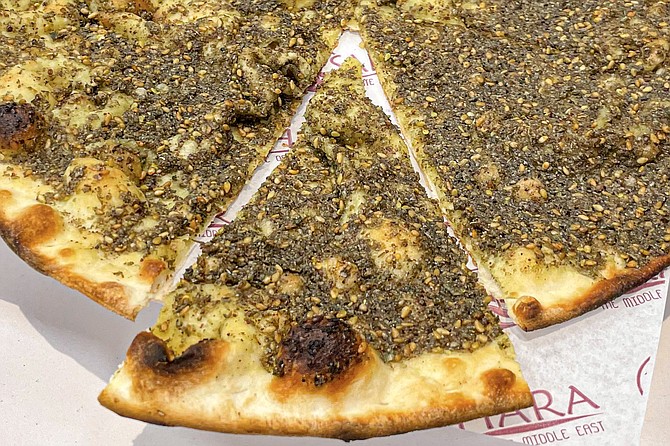
Having recently moved out of San Diego’s urban center, I’ve spent much of this year reconciling myself to the idea that, beyond the city proper, sometimes independent restaurateurs manage to outdo competition within suburban shopping centers otherwise dominated by national franchises. It’s probably citified prejudice on my part, that when I see a business attached to a mall, or stucco shopping strip, surrounded by the likes of Carl’s Jr or Little Caesars, I assume it’s a chain restaurant.
It doesn’t get more suburban than Rancho San Diego, which is basically the ‘burbs of El Cajon, previously best known to me as the place where the 94 freeway ends. That’s where Sahara Taste of the Middle East has been operating ten full years now, run by the same small business operator as the Press Box Sports Lounge next door.
Sahara started out as a tiny counter shop, but thanks to early local success, quickly expanded to more than double in size. Prior to the pandemic, it stayed open past midnight daily, which I couldn’t even say about most restaurants downtown.
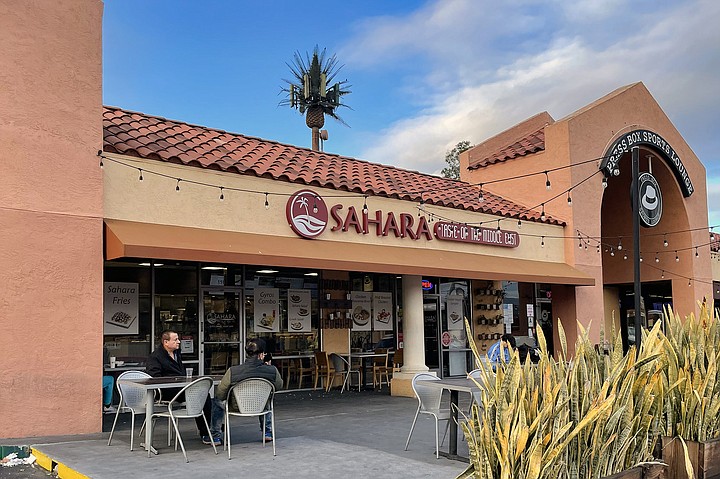
But what I immediately liked best about the place is its devotion to naturally raised proteins, meaning the chicken and beef going into its shawarmas and kabobs haven’t been pumped up with hormones. Qualms over “conventionally” raised meats is what sowed my mistrust for national chains in the first place.
Sahara’s Middle Eastern menu includes lamb and falafel, and all of the above are served with the familiar pita bread and yellow rice. That said, the place seems to embrace fusion concepts. It also puts its proteins on sandwiches of French bread, and its top selling dishes include Sahara Fries ($14-15), a take-off on carne asada fries, topped with either beef or chicken shawarma (or half and half), then drizzled with copious tahini, garlic aioli, and ranch dressing.
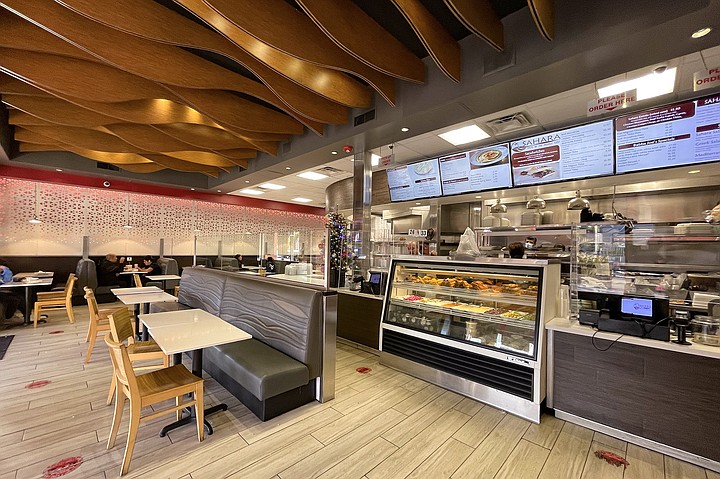
At my house, we’ve become fascinated by what Sahara cooks up inside what most of us would call a bright red pizza oven. The menu terms them flatbreads, but it looks like the Arabic term is manakish, more familiar in the plural manoushe, sometimes billed as Lebanese pizza. And these are remarkably similar to pizza: you may even order them topped with cheese ($6.50), roasted vegetable ($8.50), and/or meat toppings ($10.50). But the key difference is there’s no tomato sauce base, nor pesto, nor even garlic cream.
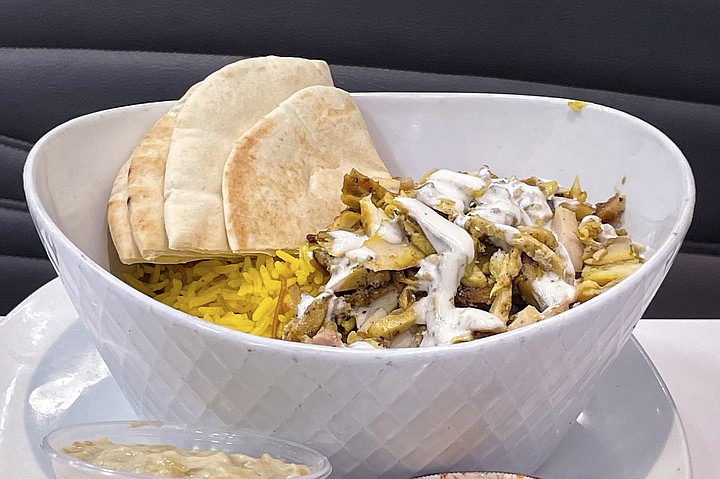
What you may get instead is olive oil and the spice blend called za’atar, which creates a super savory, green crust of oregano, thyme, salt, pepper, sumac, and toasted sesame seeds ($6.50).
You can get this *za’atar manoushe with the melted mozzarella (mized with feta) cheese pizza lovers might expect from the round flatbread’s pie-shaped slices, or spread on the strained yogurt/cheese labneh. But it’s pretty satisfying to eat one without anything but za'atar, what apparently may constitute breakfast in Lebanon. The za’atar certainly offers all the flavor you’ll need any time of day — seriously, there’s more to taste here than all but the spiciest of sausage or pepperoni.
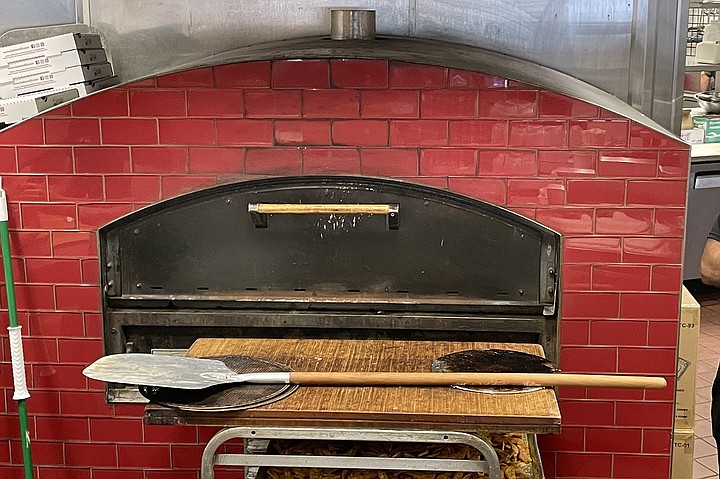
When I brought some home, the kids got excited to see a pizza box in my hands. But when they saw a seedy sea of brownish green where they expected melted mozzarella to be, they lost interest. Finally, I got them to relent and try the flatbread anyway.
“Mmm!” said the younger, with surprise. “That doesn’t look great, to be honest, but it’s actually kinda awesome!”
Which is great news, because I’d much rather dine on slices of cheesy manakish than hit that Little Caesar’s.


Having recently moved out of San Diego’s urban center, I’ve spent much of this year reconciling myself to the idea that, beyond the city proper, sometimes independent restaurateurs manage to outdo competition within suburban shopping centers otherwise dominated by national franchises. It’s probably citified prejudice on my part, that when I see a business attached to a mall, or stucco shopping strip, surrounded by the likes of Carl’s Jr or Little Caesars, I assume it’s a chain restaurant.
It doesn’t get more suburban than Rancho San Diego, which is basically the ‘burbs of El Cajon, previously best known to me as the place where the 94 freeway ends. That’s where Sahara Taste of the Middle East has been operating ten full years now, run by the same small business operator as the Press Box Sports Lounge next door.
Sahara started out as a tiny counter shop, but thanks to early local success, quickly expanded to more than double in size. Prior to the pandemic, it stayed open past midnight daily, which I couldn’t even say about most restaurants downtown.

But what I immediately liked best about the place is its devotion to naturally raised proteins, meaning the chicken and beef going into its shawarmas and kabobs haven’t been pumped up with hormones. Qualms over “conventionally” raised meats is what sowed my mistrust for national chains in the first place.
Sahara’s Middle Eastern menu includes lamb and falafel, and all of the above are served with the familiar pita bread and yellow rice. That said, the place seems to embrace fusion concepts. It also puts its proteins on sandwiches of French bread, and its top selling dishes include Sahara Fries ($14-15), a take-off on carne asada fries, topped with either beef or chicken shawarma (or half and half), then drizzled with copious tahini, garlic aioli, and ranch dressing.

At my house, we’ve become fascinated by what Sahara cooks up inside what most of us would call a bright red pizza oven. The menu terms them flatbreads, but it looks like the Arabic term is manakish, more familiar in the plural manoushe, sometimes billed as Lebanese pizza. And these are remarkably similar to pizza: you may even order them topped with cheese ($6.50), roasted vegetable ($8.50), and/or meat toppings ($10.50). But the key difference is there’s no tomato sauce base, nor pesto, nor even garlic cream.

What you may get instead is olive oil and the spice blend called za’atar, which creates a super savory, green crust of oregano, thyme, salt, pepper, sumac, and toasted sesame seeds ($6.50).
You can get this *za’atar manoushe with the melted mozzarella (mized with feta) cheese pizza lovers might expect from the round flatbread’s pie-shaped slices, or spread on the strained yogurt/cheese labneh. But it’s pretty satisfying to eat one without anything but za'atar, what apparently may constitute breakfast in Lebanon. The za’atar certainly offers all the flavor you’ll need any time of day — seriously, there’s more to taste here than all but the spiciest of sausage or pepperoni.

When I brought some home, the kids got excited to see a pizza box in my hands. But when they saw a seedy sea of brownish green where they expected melted mozzarella to be, they lost interest. Finally, I got them to relent and try the flatbread anyway.
“Mmm!” said the younger, with surprise. “That doesn’t look great, to be honest, but it’s actually kinda awesome!”
Which is great news, because I’d much rather dine on slices of cheesy manakish than hit that Little Caesar’s.
Comments